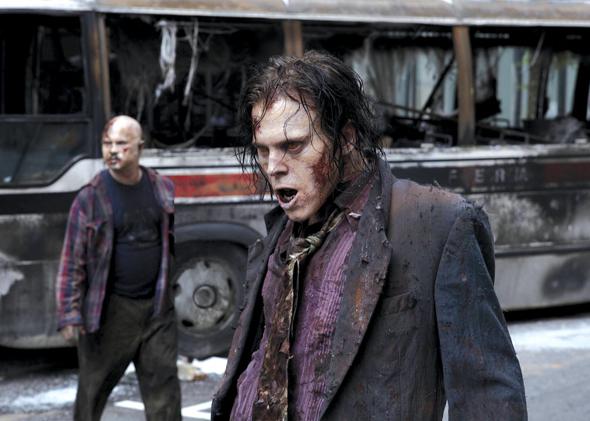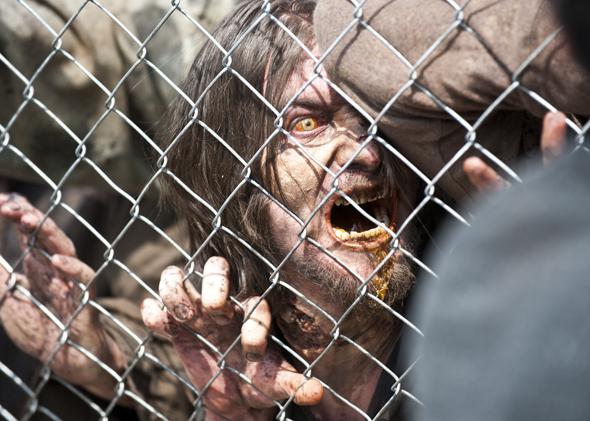In the TV series The Walking Dead, the characters inhabit a world overrun by zombies—specifically, zombies caused by a mysterious virus that has apparently infected everyone in the population. The living keep the virus in check by unknown means. But when someone dies—whether quickly after being bitten by a “walker” or felled by a human nemesis or more slowly due to natural causes—the result is the same: After death, everyone is reanimated as a bloodthirsty zombie. The pandemic survivors come to realize that the zombies aren’t their only enemies: The living can be even more dangerous than the undead. The group of main characters has spent several seasons searching for a safe haven against both walkers and unsavory living people. The beginning of Season 4 finds them ensconced in a prison, the series regulars merged with new characters from the nearby town of Woodbury.
The premise that all living people are already infected with the zombie virus was introduced in Season 1, during a foray to the Centers for Disease Control and Prevention, where the lone remaining CDC scientist—Edwin Jenner—informed Rick, the de facto leader of the survivors, of this fact. (However, Rick didn’t tell the rest of the group—and thus the audience—this particular tidbit of information until the end of Season 2.) To date, this revelation has been the central plot point, in terms of public health. Unlike the movie version of World War Z, there has been little attention paid to how this zombie pandemic began or how to end it—the focus is on daily survival. Understanding the virus probably wouldn’t matter much at this point in any case—mathematical modeling has shown that, unless you hit hard and hit early, there’s pretty much no stopping a zombie pandemic once it starts. Add on the fact that, based on the survivors’ CDC experience, all research into the cause (and therefore any cure, treatment, or prevention) has stopped … well, the ragtag group appears to be on its own.
It might not seem like things could get any worse, but as the group found out in this week’s episode, “Infected,” the zombie pandemic virus isn’t the only killer pathogen out there. We know from all-too-real examples that one disaster often breeds another. In the real world, an ongoing cholera outbreak is plaguing Haiti. After the 2010 earthquake, United Nations troops inadvertently introduced the pathogen, and the country lost much of its health infrastructure during the earthquake. The HIV pandemic has exacerbated other infectious diseases, such as multidrug resistant tuberculosis, particularly in Africa. Wars and their resulting refugee camps are breeding grounds for a multitude of infectious diseases, including deadly respiratory and diarrheal infections. As routine vaccination programs lapse in disaster areas, killers such as measles, tetanus, and polio can make a resurgence.
The principle that disaster breeds disaster is what our long-suffering group discovered on Sunday’s episode. In the midst of the infectious zombie pandemic, another killer germ arose, quickly leading to the death of new character Patrick in a rather gruesome manner. The new virus seems to be influenza (and probably swine influenza). Hershel, a veterinarian, notes that influenza can be transmitted to humans from pigs and birds—it’s a zoonotic infection. Rick adds that he saw a sick boar during a prior excursion in the woods and that he saw other zombies along the fence outside their prison home that resembled the recently reanimated Patrick: trailing blood from their eyes, nose, and lips. Another character, Dr. Subramanian, explains that this is due to pressure building up in the lungs from the infection, and then it’s “like you shake a soda can and pop the top, only your eyes, ears, nose, and throat are the top.”
In our world, swine flu usually isn’t fatal, nor is it highly contagious among humans. Clinical manifestations like those that affected Patrick would be exceedingly rare, though some have been seen from the novel H1N1 virus, which originated in swine and caused a 2009 pandemic, and also from the 1918 pandemic influenza virus, which was of avian origin. (And, breaking out at the end of World War I, the 1918 pandemic is a prime example of an epidemiological disaster facilitated by the disaster of war.) The coughing symptoms some of the survivors are showing would also be consistent with influenza infections, but that’s hardly diagnostic—many respiratory germs cause coughing.
Hershel, as a veterinarian, should also be considering other pathogens that could sicken both people and pigs. One that immediately comes to mind is called Streptococcus suis, a bacterium that causes flu-like symptoms and can jump between swine and humans. It can also cause hemorrhagic (bleeding) manifestations, as noted in an outbreak in China in 2005. The big difference between S. suis and flu is that the former is not known to be transmitted among humans—people who get sick with it are usually in direct contact with pigs, so Rick and his son Carl, who had been raising pigs on a farm within the fenced prison grounds, would be at the highest risk for infection.

Photo courtesy of Gene Page/AMC
Why is a diagnosis important? The group decides in this episode to isolate people who are showing symptoms of the disease. (The next episode, in fact, is called “Isolation.”) If the pathogen is indeed swine influenza, and if it was already spreading among the humans in the prison, Rick’s step of sacrificing the piglets to the zombie horde would do little to nothing to stop the illness. If, however, it was S. suis, isolation probably wouldn’t even be necessary—keeping people away from the pigs should do the trick and end the epidemic.
Could such a diagnosis be made in the middle of an apocalypse? Definitively, probably not—but the group has both a veterinarian and a physician within the prison. It wouldn’t take much to do a crude epidemiological analysis, asking those who are coughing if they’d been exposed to pigs or how much time they’d spent around other (possibly sick) people. If all the sick people cluster together and haven’t been around the pigs at all, flu is a more logical choice, which may have originated in the pigs or the people. (An overcrowded prison, with people mixing from two recently assimilated communities, is certainly a great place for infectious diseases to spread.) To complicate matters, Rick correctly mentions to Carl at the end of the episode that the pigs could have made people sick or people could have sickened the pigs—many germs don’t care about species boundaries. There’s also the mysterious rat-feeder introduced in Sunday’s episode: Someone within the prison is catching live rats and feeding them to the zombie horde lingering outside the prison gates. Rats are notorious vectors of disease. Do they play a role in this new outbreak?
More answers may come in the next episodes. Perhaps the zombie virus itself will jump species, as it does in Jonathan Maberry’s Rot and Ruin series (zombie boars) or Mira Grant’s Newsflesh trilogy (zombie bears). Animals may have more to fear from a zombie pandemic than was previously thought.
